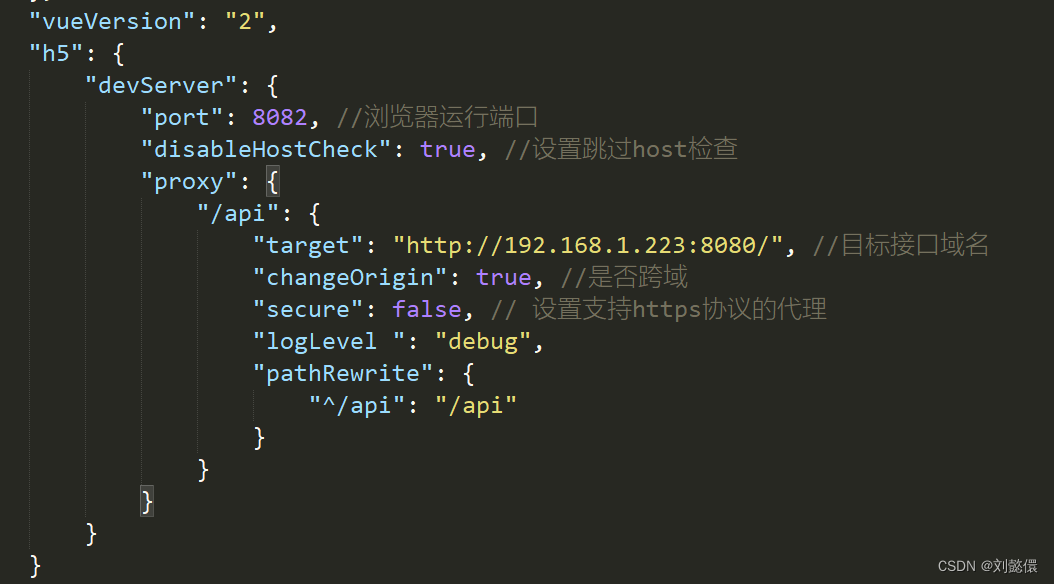1.路由跳转的问题
uni.navigateTo() 保留当前页面,跳转到应用内的某个页面,使用uni.navigateBack可以返回到原页面
uni.redirectTo()
关闭当前页面,跳转到应用内的某个页面。
uni.reLaunch()
关闭所有页面,打开到应用内的某个页面
uni.switchTab()
跳转到 tabBar 页面,并关闭其他所有非 tabBar 页面。
uni.navigateBack()
关闭当前页面,返回上一页面或多级页面。可通过 getCurrentPages() 获取当前的页面栈,决定需要返回几层。
2.tabBar的使用
tabBar": {"color": "#333333","selectedColor": "#1890FF","backgroundColor": "#ffffff","list": [{"pagePath": "pages/index/index", //页面路径"text": "首页", //按钮文字"iconPath": "static/首页01.png", //图片路径"selectedIconPath": "static/首页001.png" //选中的图片路径},{"pagePath": "pages/addwork/addwork","text": "添加","iconPath": "static/添加01.png","selectedIconPath": "static/添加001.png"},{"pagePath": "pages/user/user","text": "我的","iconPath": "static/我的01.png","selectedIconPath": "static/我的001.png"}]}
3.u-view组件的引入
刚开始时下载的2.0版本的u-view,看的1.8的文档,一直引入不对,只能通过important引入,在注册,之后才能使用,中间还发现有些组件不能用,后面发现了问题,换成2.0版本的文档,立马就能引入了,还是直接引入,不需要通过important引入,也不需要注册了,直接写标签就可以了
4.u-view组件的使用
使用过程中,有些属性方法,文档上没有,这个时候需要看他的github,直接看他的源码,就行了
5.组件的样式修改
1.在全局文件里面修改,这样会直接覆盖组件的样式
2.Vue 中,
::v-deep 用于深度作用选择器,可以让样式穿透到子组件中。
:global 则用于全局作用选择器,可以使样式不受组件的限制。
6.命名规范
一定要在刚开始的时候商量好,要不多人合作容易出现不同的风格
7.rpx和view的使用
都是为了自适应屏幕
8.前后端对接
一定要商量要不然会有进度差异,命名格式,字段名称啥的都说好,方便彼此,要不然后面修改不好修改
9需求文档
越早编写越好。这样对项目有一个明了的认识
10,axios的配置
import axios from 'axios';// create an axios instance
const http = axios.create({baseURL: '', // url = base url + request url// withCredentials: true, // send cookies when cross-domain requests 注意:withCredentials和后端配置的cross跨域不可同时使用timeout: 4000, // request timeoutcrossDomain: true,
});// request拦截器,在请求之前做一些处理
http.interceptors.request.use((config) => {// if (store.state.token) {// // 给请求头添加user-token// config.headers["user-token"] = store.state.token;// }console.log(config.data);console.log('请求拦截成功');config.data = JSON.stringify(config.data);return config;},// const token = uni.getStorageSync("linkToken");// config.headers['Content-Type'] = 'application/json';// if (token) {// config.headers.Authorization = `Bearer ${token}`;// }// return config;// },(error) => {console.log(error); // for debugconsole.log('sssssssssssssss');return Promise.reject(error);}
);// 配置成功后的拦截器
http.interceptors.response.use((res) => {console.log(res);if (res.status === 200) {return res.data;} else {return Promise.reject(res.data.msg);}
}, (error) => {console.log(error);if (error.request.status) {switch (error.response.status) {case 401:break;default:break;}}return Promise.reject(error);
});// 在main.js中放入这段自定义适配器的代码,就可以实现uniapp的app和小程序开发中能使用axios进行跨域网络请求,并支持携带cookie
axios.defaults.adapter = function (config) {return new Promise((resolve, reject) => {console.log(config);const settle = require('axios/lib/core/settle');const buildURL = require('axios/lib/helpers/buildURL');uni.request({method: config.method.toUpperCase(),url: config.baseURL + buildURL(config.url, config.params, config.paramsSerializer),header: config.headers,data: config.data,dataType: config.dataType,responseType: config.responseType,sslVerify: config.sslVerify,complete: function complete(response) {console.log('执行完成:', response);response = {data: response.data,status: response.statusCode,errMsg: response.errMsg,header: response.header,config,};settle(resolve, reject, response);},});});
};export default http;
11.axios配置过程中的问题
包的丢失,因为创建文件夹的时候是先创了一个文件夹,又创了项目,所以导致项目的的名称和文件的名称一摸一样,有的包配置的时候不知道怎么回事跑到了项目外面,导致的一直配置不出来,后面来回来就行了
12.样式不用写的那么急,先把模块设计好,后面的时候,再调就好了,写样式的时候可以参照网上的项目,要不自己凭感觉写的,不太好看
13.后端接口,先测试
这次写的时候,调用总宁的接口,能调用上去,但是这边一直一直传数据传不过去,最后问了学长,是自己配代理服务器的时候用的两个的端口都用的同一个,导致出的问题,
和后端连接我这边出了不少问题,一直有问题,一直改,还是太菜了
14.表单的检验
写表单的时候光注意样式了,复制的人家的源码,觉得上面的东西太多了,我就都删了,最后效果也能实现,但是没有检验了,后面能调用接口了,发现越来越别扭,因为没有校验,所以写啥都能过,果然不能省事,所以后面我还得再补,有点难受了,后面还得写reuls,还由页面结构也得在补包裹的对象
15.token的传递
在axios的配置里面可以直接传递

16.全局设置请求

target里面的http需要写不写的话,会报500错误
17,页面传参
通过url传参
url: /pages/workdetail/workdetail?id=${this.id}
18页面传参的时候出现问题
注意看apifoxs可能是后端的问题,也可能是前端的问题

















)

